Strategic Human Resource Management for Work-Life Balance at PepsiCo
VerifiedAdded on 2023/06/11
|12
|2998
|157
AI Summary
This essay explores the various aspects of PepsiCo’s leave loud policy and its strategic focus on retaining talents through work-life balance provisions. It discusses the rationale for implementing the ‘leave loudly’ strategy and its alignment with other HR practices such as equity and diversity, workforce planning and development, social responsibility, and work-life balance. The impact of CEO personal life in the implementation of ‘leave loudly’ strategy and its impact on workplace morale and productivity are also discussed.
Contribute Materials
Your contribution can guide someone’s learning journey. Share your
documents today.
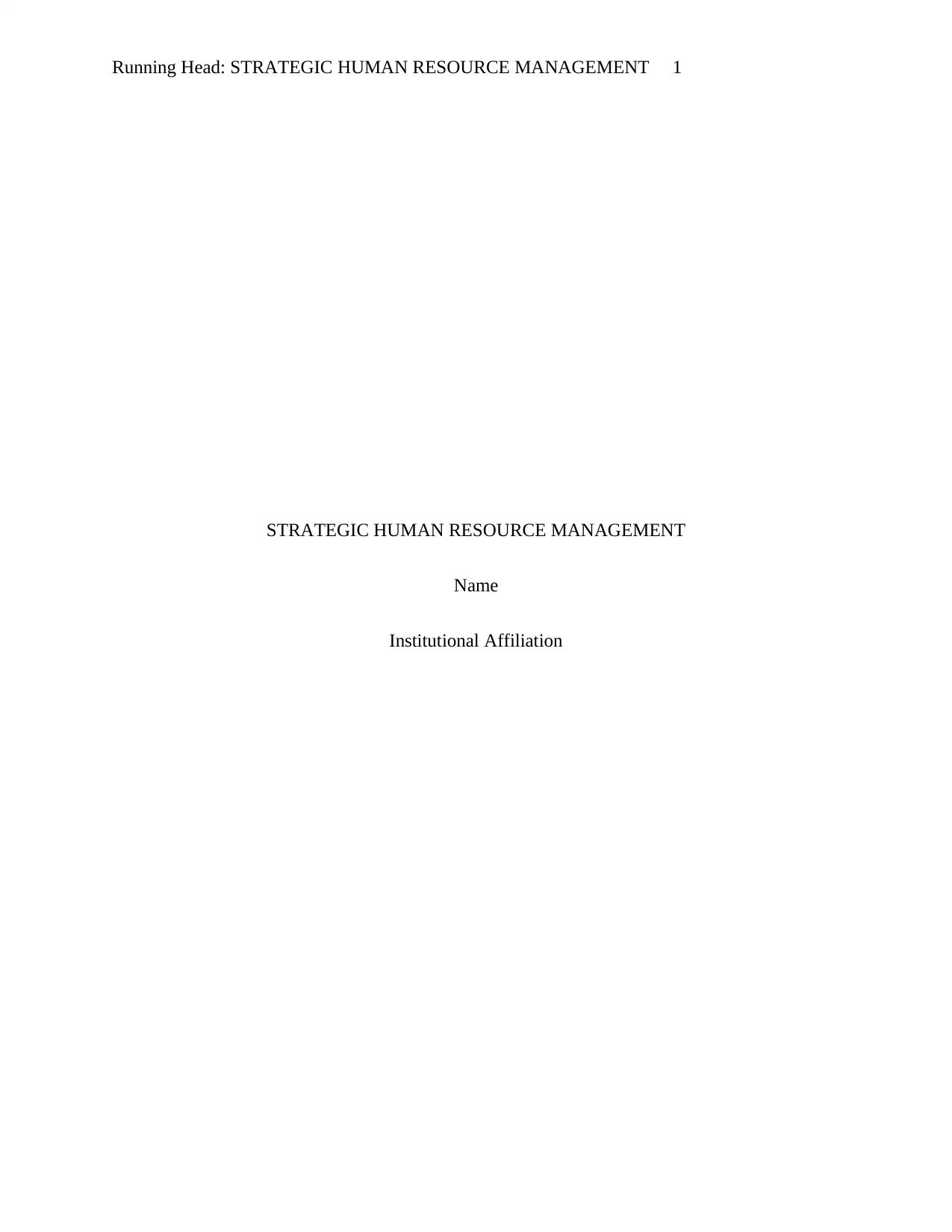
Running Head: STRATEGIC HUMAN RESOURCE MANAGEMENT 1
STRATEGIC HUMAN RESOURCE MANAGEMENT
Name
Institutional Affiliation
STRATEGIC HUMAN RESOURCE MANAGEMENT
Name
Institutional Affiliation
Secure Best Marks with AI Grader
Need help grading? Try our AI Grader for instant feedback on your assignments.
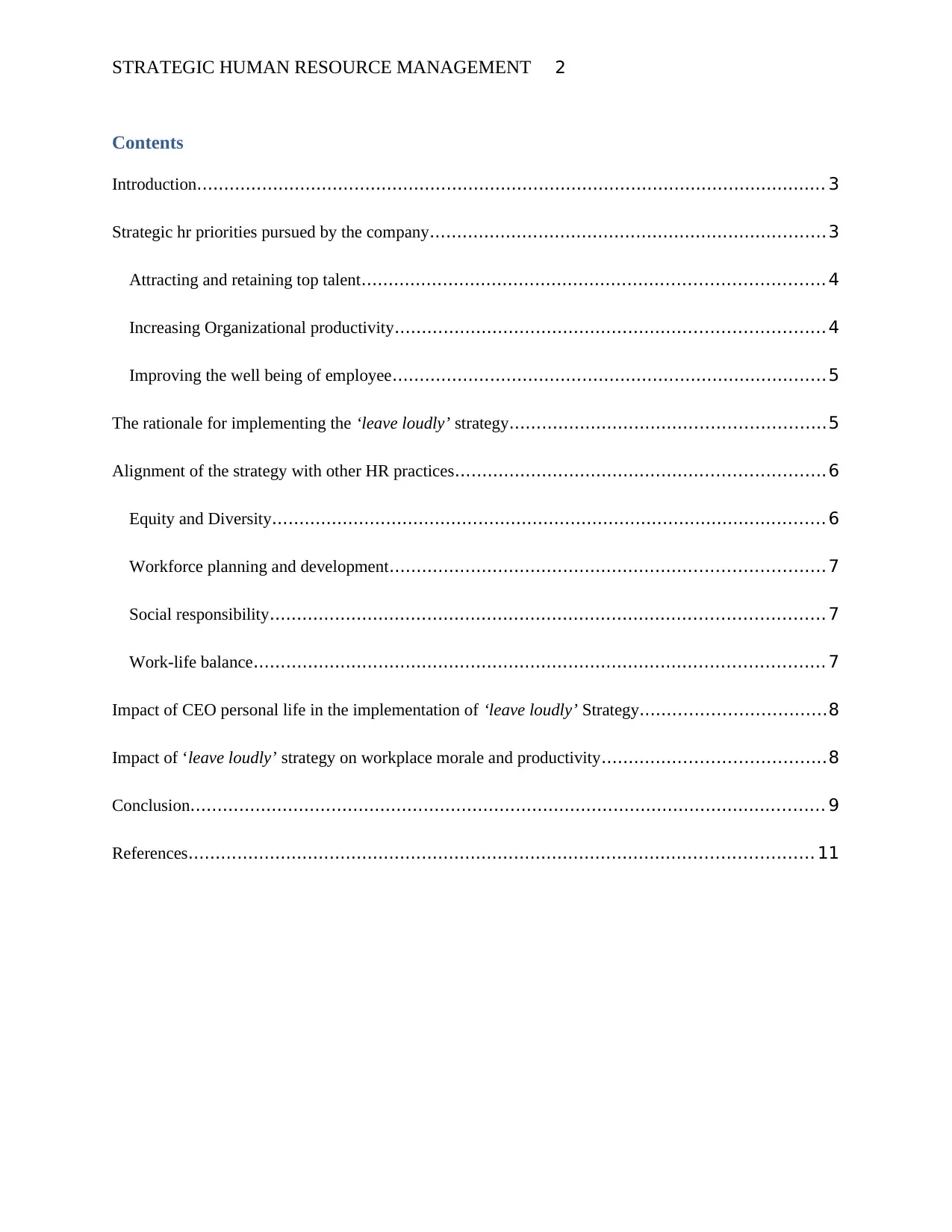
STRATEGIC HUMAN RESOURCE MANAGEMENT 2
Contents
Introduction.................................................................................................................... 3
Strategic hr priorities pursued by the company.........................................................................3
Attracting and retaining top talent..................................................................................... 4
Increasing Organizational productivity............................................................................... 4
Improving the well being of employee................................................................................5
The rationale for implementing the ‘leave loudly’ strategy..........................................................5
Alignment of the strategy with other HR practices....................................................................6
Equity and Diversity...................................................................................................... 6
Workforce planning and development................................................................................ 7
Social responsibility...................................................................................................... 7
Work-life balance......................................................................................................... 7
Impact of CEO personal life in the implementation of ‘leave loudly’ Strategy..................................8
Impact of ‘leave loudly’ strategy on workplace morale and productivity.........................................8
Conclusion..................................................................................................................... 9
References................................................................................................................... 11
Contents
Introduction.................................................................................................................... 3
Strategic hr priorities pursued by the company.........................................................................3
Attracting and retaining top talent..................................................................................... 4
Increasing Organizational productivity............................................................................... 4
Improving the well being of employee................................................................................5
The rationale for implementing the ‘leave loudly’ strategy..........................................................5
Alignment of the strategy with other HR practices....................................................................6
Equity and Diversity...................................................................................................... 6
Workforce planning and development................................................................................ 7
Social responsibility...................................................................................................... 7
Work-life balance......................................................................................................... 7
Impact of CEO personal life in the implementation of ‘leave loudly’ Strategy..................................8
Impact of ‘leave loudly’ strategy on workplace morale and productivity.........................................8
Conclusion..................................................................................................................... 9
References................................................................................................................... 11
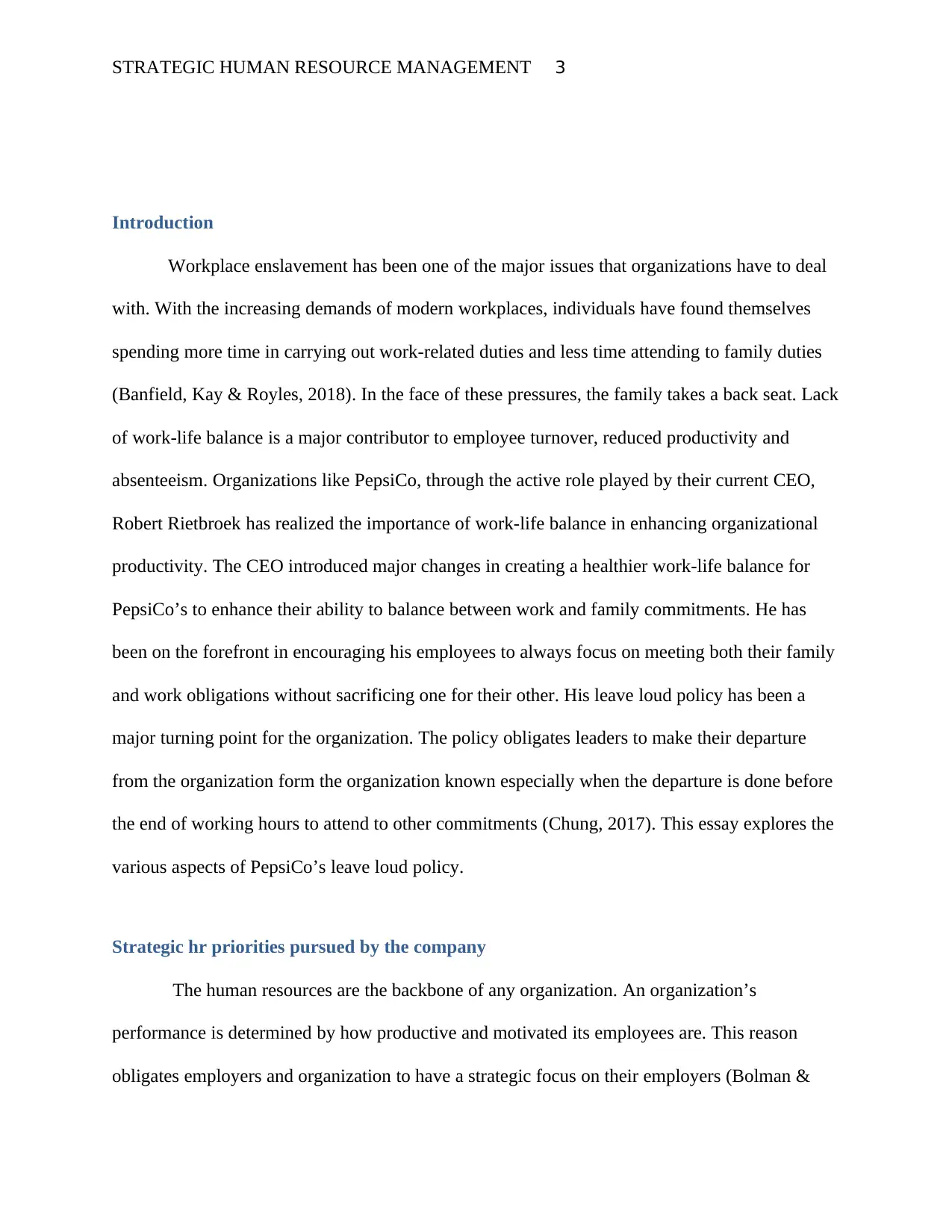
STRATEGIC HUMAN RESOURCE MANAGEMENT 3
Introduction
Workplace enslavement has been one of the major issues that organizations have to deal
with. With the increasing demands of modern workplaces, individuals have found themselves
spending more time in carrying out work-related duties and less time attending to family duties
(Banfield, Kay & Royles, 2018). In the face of these pressures, the family takes a back seat. Lack
of work-life balance is a major contributor to employee turnover, reduced productivity and
absenteeism. Organizations like PepsiCo, through the active role played by their current CEO,
Robert Rietbroek has realized the importance of work-life balance in enhancing organizational
productivity. The CEO introduced major changes in creating a healthier work-life balance for
PepsiCo’s to enhance their ability to balance between work and family commitments. He has
been on the forefront in encouraging his employees to always focus on meeting both their family
and work obligations without sacrificing one for their other. His leave loud policy has been a
major turning point for the organization. The policy obligates leaders to make their departure
from the organization form the organization known especially when the departure is done before
the end of working hours to attend to other commitments (Chung, 2017). This essay explores the
various aspects of PepsiCo’s leave loud policy.
Strategic hr priorities pursued by the company
The human resources are the backbone of any organization. An organization’s
performance is determined by how productive and motivated its employees are. This reason
obligates employers and organization to have a strategic focus on their employers (Bolman &
Introduction
Workplace enslavement has been one of the major issues that organizations have to deal
with. With the increasing demands of modern workplaces, individuals have found themselves
spending more time in carrying out work-related duties and less time attending to family duties
(Banfield, Kay & Royles, 2018). In the face of these pressures, the family takes a back seat. Lack
of work-life balance is a major contributor to employee turnover, reduced productivity and
absenteeism. Organizations like PepsiCo, through the active role played by their current CEO,
Robert Rietbroek has realized the importance of work-life balance in enhancing organizational
productivity. The CEO introduced major changes in creating a healthier work-life balance for
PepsiCo’s to enhance their ability to balance between work and family commitments. He has
been on the forefront in encouraging his employees to always focus on meeting both their family
and work obligations without sacrificing one for their other. His leave loud policy has been a
major turning point for the organization. The policy obligates leaders to make their departure
from the organization form the organization known especially when the departure is done before
the end of working hours to attend to other commitments (Chung, 2017). This essay explores the
various aspects of PepsiCo’s leave loud policy.
Strategic hr priorities pursued by the company
The human resources are the backbone of any organization. An organization’s
performance is determined by how productive and motivated its employees are. This reason
obligates employers and organization to have a strategic focus on their employers (Bolman &
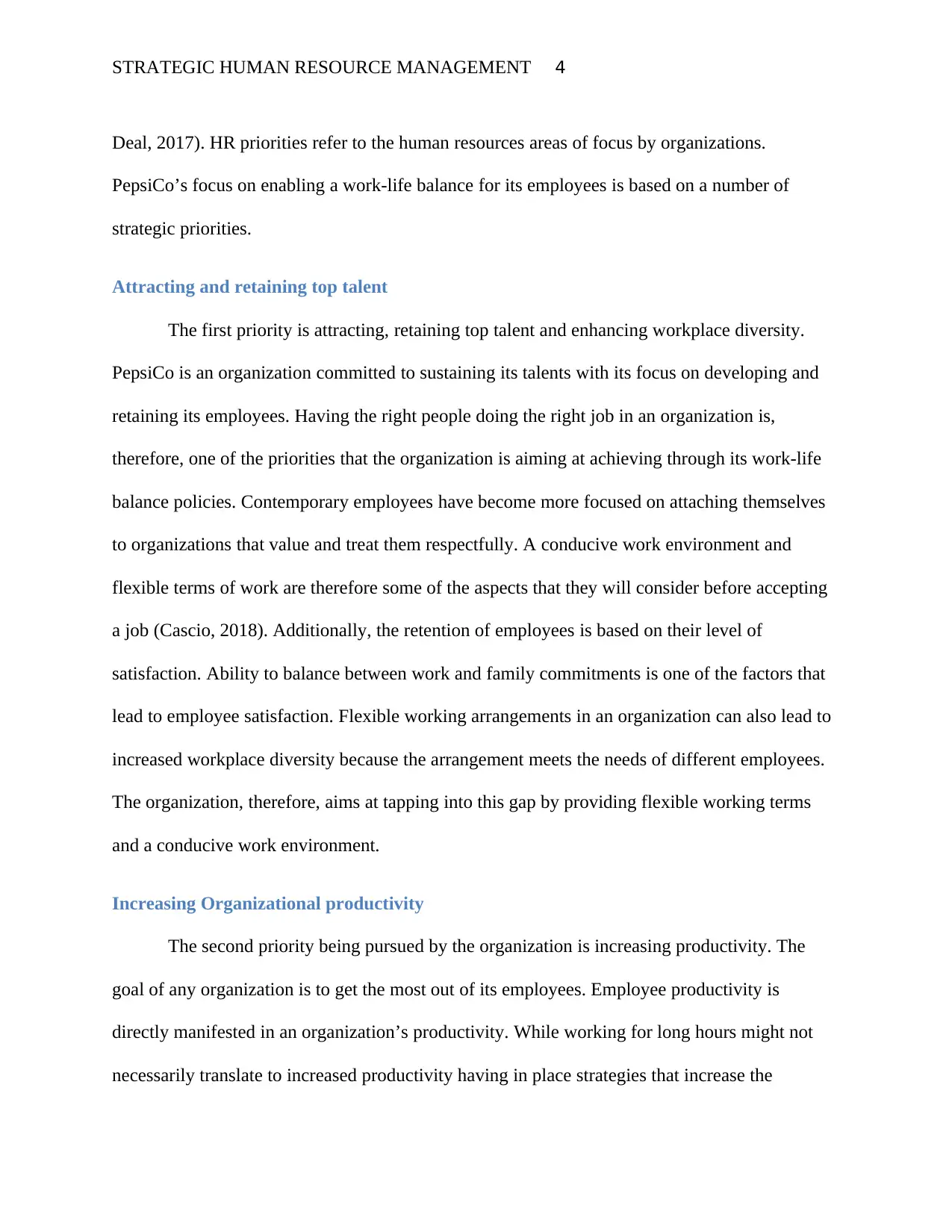
STRATEGIC HUMAN RESOURCE MANAGEMENT 4
Deal, 2017). HR priorities refer to the human resources areas of focus by organizations.
PepsiCo’s focus on enabling a work-life balance for its employees is based on a number of
strategic priorities.
Attracting and retaining top talent
The first priority is attracting, retaining top talent and enhancing workplace diversity.
PepsiCo is an organization committed to sustaining its talents with its focus on developing and
retaining its employees. Having the right people doing the right job in an organization is,
therefore, one of the priorities that the organization is aiming at achieving through its work-life
balance policies. Contemporary employees have become more focused on attaching themselves
to organizations that value and treat them respectfully. A conducive work environment and
flexible terms of work are therefore some of the aspects that they will consider before accepting
a job (Cascio, 2018). Additionally, the retention of employees is based on their level of
satisfaction. Ability to balance between work and family commitments is one of the factors that
lead to employee satisfaction. Flexible working arrangements in an organization can also lead to
increased workplace diversity because the arrangement meets the needs of different employees.
The organization, therefore, aims at tapping into this gap by providing flexible working terms
and a conducive work environment.
Increasing Organizational productivity
The second priority being pursued by the organization is increasing productivity. The
goal of any organization is to get the most out of its employees. Employee productivity is
directly manifested in an organization’s productivity. While working for long hours might not
necessarily translate to increased productivity having in place strategies that increase the
Deal, 2017). HR priorities refer to the human resources areas of focus by organizations.
PepsiCo’s focus on enabling a work-life balance for its employees is based on a number of
strategic priorities.
Attracting and retaining top talent
The first priority is attracting, retaining top talent and enhancing workplace diversity.
PepsiCo is an organization committed to sustaining its talents with its focus on developing and
retaining its employees. Having the right people doing the right job in an organization is,
therefore, one of the priorities that the organization is aiming at achieving through its work-life
balance policies. Contemporary employees have become more focused on attaching themselves
to organizations that value and treat them respectfully. A conducive work environment and
flexible terms of work are therefore some of the aspects that they will consider before accepting
a job (Cascio, 2018). Additionally, the retention of employees is based on their level of
satisfaction. Ability to balance between work and family commitments is one of the factors that
lead to employee satisfaction. Flexible working arrangements in an organization can also lead to
increased workplace diversity because the arrangement meets the needs of different employees.
The organization, therefore, aims at tapping into this gap by providing flexible working terms
and a conducive work environment.
Increasing Organizational productivity
The second priority being pursued by the organization is increasing productivity. The
goal of any organization is to get the most out of its employees. Employee productivity is
directly manifested in an organization’s productivity. While working for long hours might not
necessarily translate to increased productivity having in place strategies that increase the
Secure Best Marks with AI Grader
Need help grading? Try our AI Grader for instant feedback on your assignments.
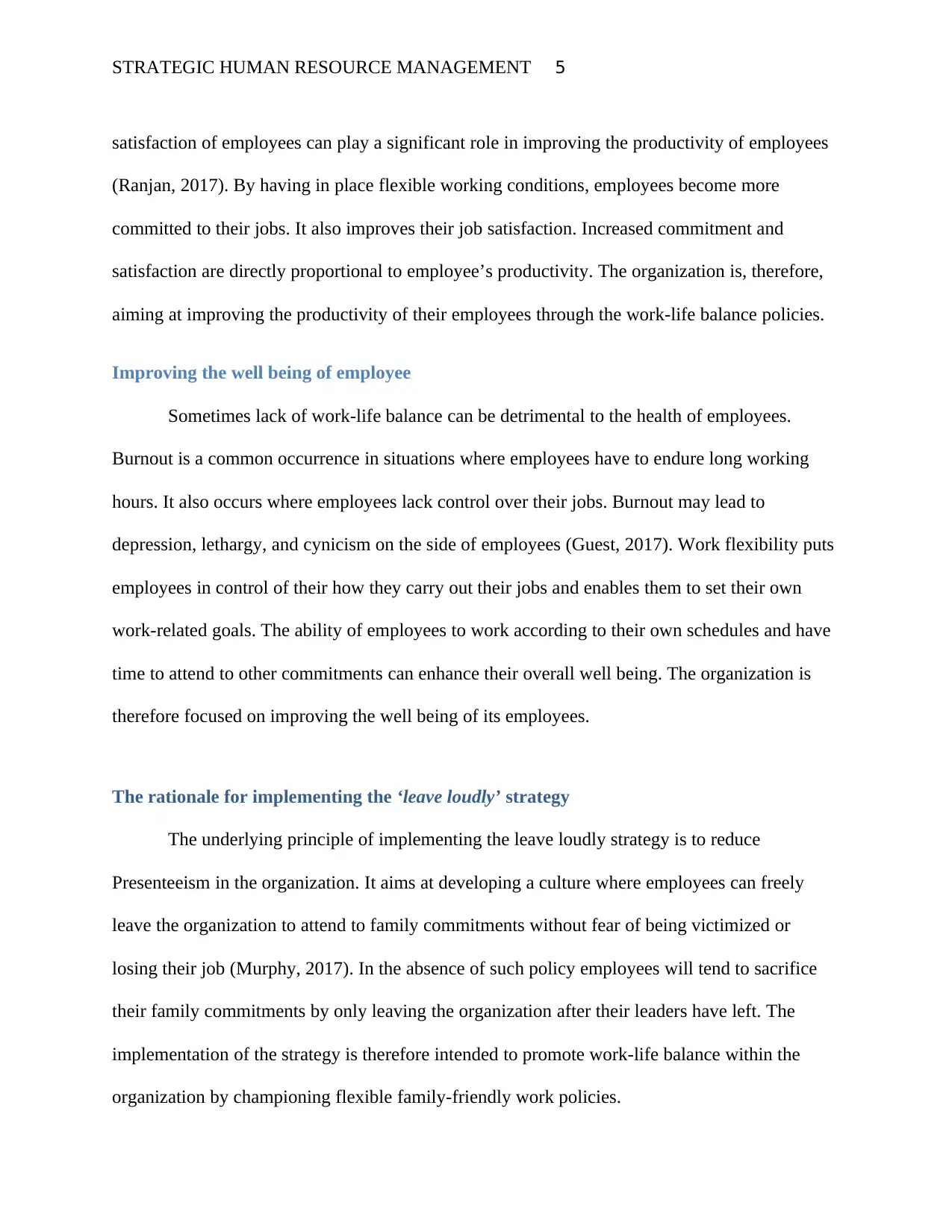
STRATEGIC HUMAN RESOURCE MANAGEMENT 5
satisfaction of employees can play a significant role in improving the productivity of employees
(Ranjan, 2017). By having in place flexible working conditions, employees become more
committed to their jobs. It also improves their job satisfaction. Increased commitment and
satisfaction are directly proportional to employee’s productivity. The organization is, therefore,
aiming at improving the productivity of their employees through the work-life balance policies.
Improving the well being of employee
Sometimes lack of work-life balance can be detrimental to the health of employees.
Burnout is a common occurrence in situations where employees have to endure long working
hours. It also occurs where employees lack control over their jobs. Burnout may lead to
depression, lethargy, and cynicism on the side of employees (Guest, 2017). Work flexibility puts
employees in control of their how they carry out their jobs and enables them to set their own
work-related goals. The ability of employees to work according to their own schedules and have
time to attend to other commitments can enhance their overall well being. The organization is
therefore focused on improving the well being of its employees.
The rationale for implementing the ‘leave loudly’ strategy
The underlying principle of implementing the leave loudly strategy is to reduce
Presenteeism in the organization. It aims at developing a culture where employees can freely
leave the organization to attend to family commitments without fear of being victimized or
losing their job (Murphy, 2017). In the absence of such policy employees will tend to sacrifice
their family commitments by only leaving the organization after their leaders have left. The
implementation of the strategy is therefore intended to promote work-life balance within the
organization by championing flexible family-friendly work policies.
satisfaction of employees can play a significant role in improving the productivity of employees
(Ranjan, 2017). By having in place flexible working conditions, employees become more
committed to their jobs. It also improves their job satisfaction. Increased commitment and
satisfaction are directly proportional to employee’s productivity. The organization is, therefore,
aiming at improving the productivity of their employees through the work-life balance policies.
Improving the well being of employee
Sometimes lack of work-life balance can be detrimental to the health of employees.
Burnout is a common occurrence in situations where employees have to endure long working
hours. It also occurs where employees lack control over their jobs. Burnout may lead to
depression, lethargy, and cynicism on the side of employees (Guest, 2017). Work flexibility puts
employees in control of their how they carry out their jobs and enables them to set their own
work-related goals. The ability of employees to work according to their own schedules and have
time to attend to other commitments can enhance their overall well being. The organization is
therefore focused on improving the well being of its employees.
The rationale for implementing the ‘leave loudly’ strategy
The underlying principle of implementing the leave loudly strategy is to reduce
Presenteeism in the organization. It aims at developing a culture where employees can freely
leave the organization to attend to family commitments without fear of being victimized or
losing their job (Murphy, 2017). In the absence of such policy employees will tend to sacrifice
their family commitments by only leaving the organization after their leaders have left. The
implementation of the strategy is therefore intended to promote work-life balance within the
organization by championing flexible family-friendly work policies.
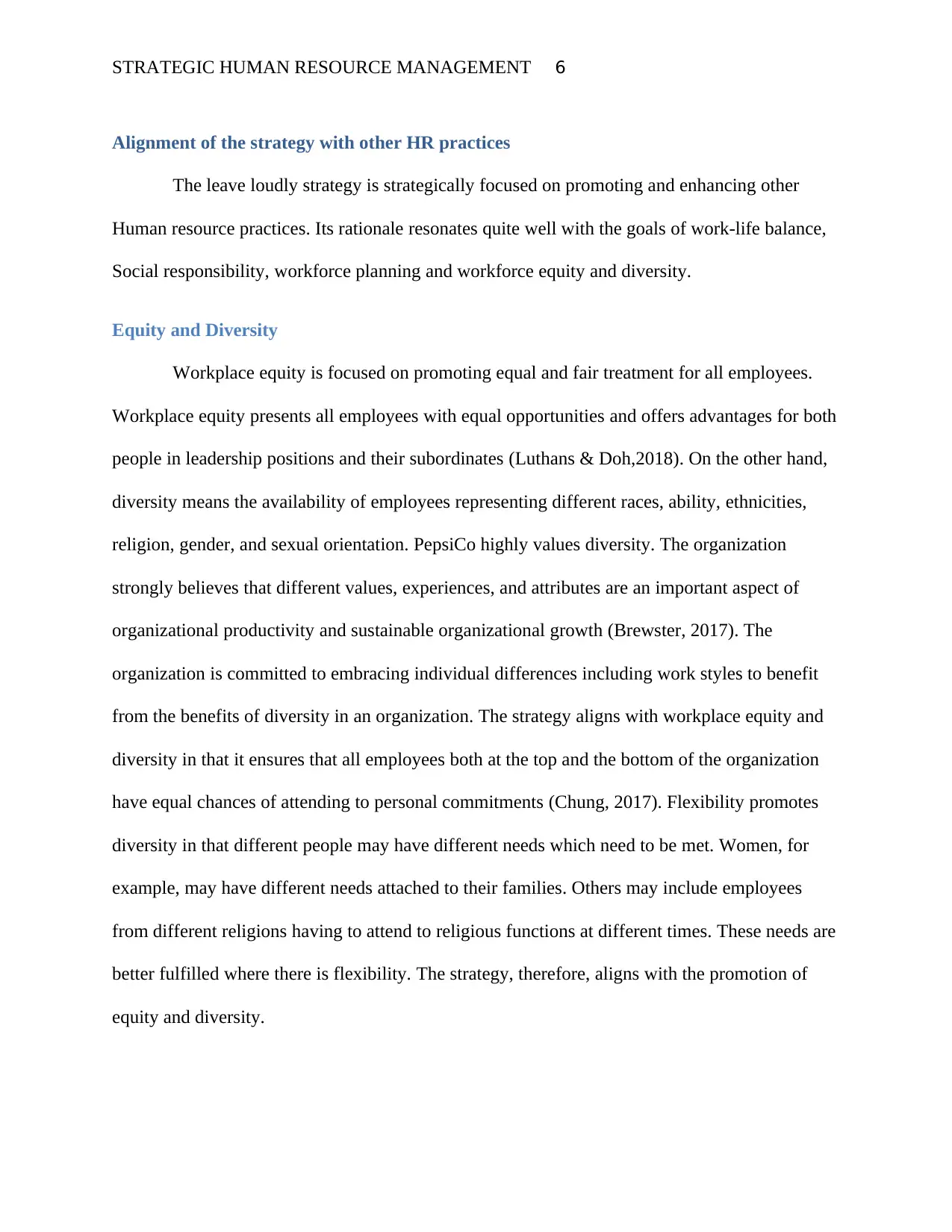
STRATEGIC HUMAN RESOURCE MANAGEMENT 6
Alignment of the strategy with other HR practices
The leave loudly strategy is strategically focused on promoting and enhancing other
Human resource practices. Its rationale resonates quite well with the goals of work-life balance,
Social responsibility, workforce planning and workforce equity and diversity.
Equity and Diversity
Workplace equity is focused on promoting equal and fair treatment for all employees.
Workplace equity presents all employees with equal opportunities and offers advantages for both
people in leadership positions and their subordinates (Luthans & Doh,2018). On the other hand,
diversity means the availability of employees representing different races, ability, ethnicities,
religion, gender, and sexual orientation. PepsiCo highly values diversity. The organization
strongly believes that different values, experiences, and attributes are an important aspect of
organizational productivity and sustainable organizational growth (Brewster, 2017). The
organization is committed to embracing individual differences including work styles to benefit
from the benefits of diversity in an organization. The strategy aligns with workplace equity and
diversity in that it ensures that all employees both at the top and the bottom of the organization
have equal chances of attending to personal commitments (Chung, 2017). Flexibility promotes
diversity in that different people may have different needs which need to be met. Women, for
example, may have different needs attached to their families. Others may include employees
from different religions having to attend to religious functions at different times. These needs are
better fulfilled where there is flexibility. The strategy, therefore, aligns with the promotion of
equity and diversity.
Alignment of the strategy with other HR practices
The leave loudly strategy is strategically focused on promoting and enhancing other
Human resource practices. Its rationale resonates quite well with the goals of work-life balance,
Social responsibility, workforce planning and workforce equity and diversity.
Equity and Diversity
Workplace equity is focused on promoting equal and fair treatment for all employees.
Workplace equity presents all employees with equal opportunities and offers advantages for both
people in leadership positions and their subordinates (Luthans & Doh,2018). On the other hand,
diversity means the availability of employees representing different races, ability, ethnicities,
religion, gender, and sexual orientation. PepsiCo highly values diversity. The organization
strongly believes that different values, experiences, and attributes are an important aspect of
organizational productivity and sustainable organizational growth (Brewster, 2017). The
organization is committed to embracing individual differences including work styles to benefit
from the benefits of diversity in an organization. The strategy aligns with workplace equity and
diversity in that it ensures that all employees both at the top and the bottom of the organization
have equal chances of attending to personal commitments (Chung, 2017). Flexibility promotes
diversity in that different people may have different needs which need to be met. Women, for
example, may have different needs attached to their families. Others may include employees
from different religions having to attend to religious functions at different times. These needs are
better fulfilled where there is flexibility. The strategy, therefore, aligns with the promotion of
equity and diversity.
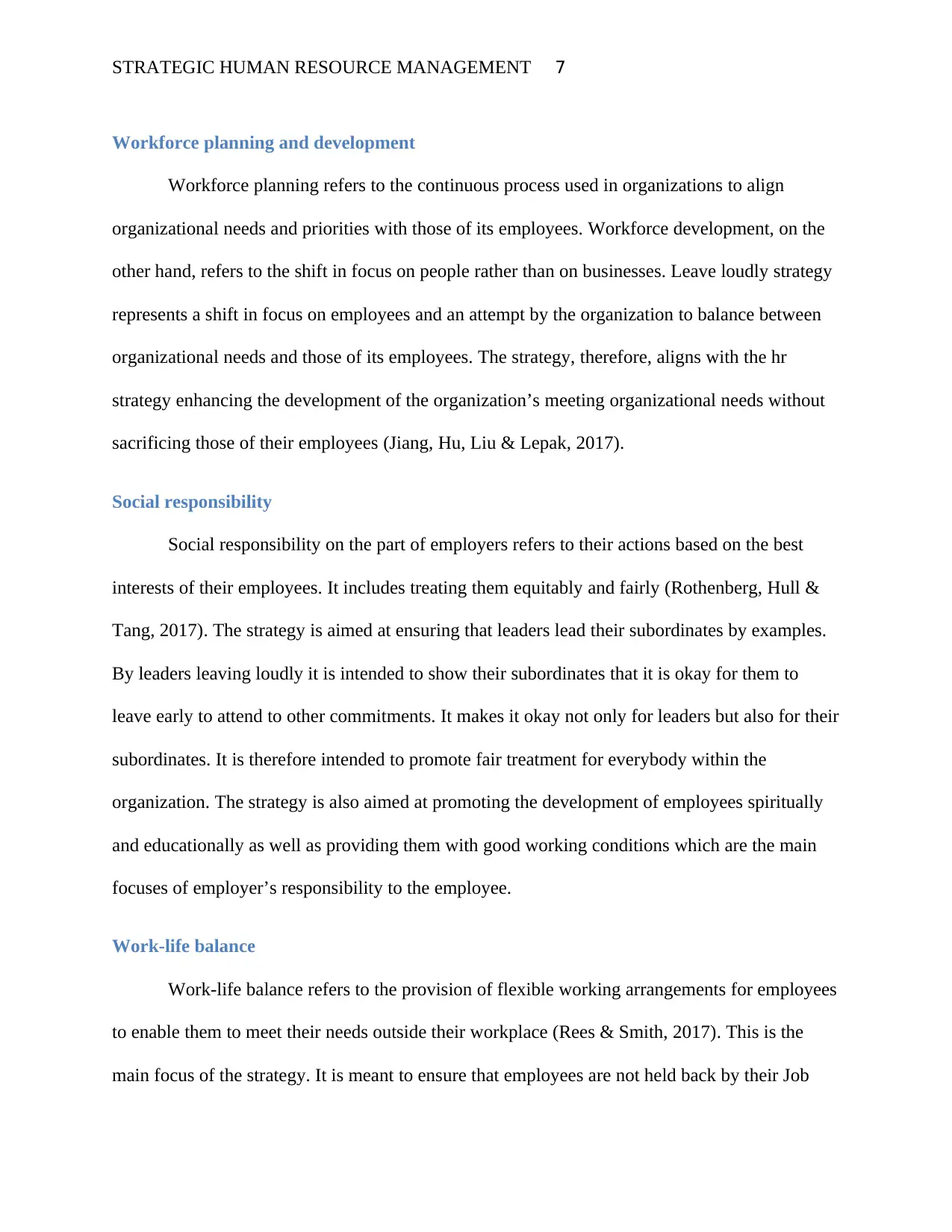
STRATEGIC HUMAN RESOURCE MANAGEMENT 7
Workforce planning and development
Workforce planning refers to the continuous process used in organizations to align
organizational needs and priorities with those of its employees. Workforce development, on the
other hand, refers to the shift in focus on people rather than on businesses. Leave loudly strategy
represents a shift in focus on employees and an attempt by the organization to balance between
organizational needs and those of its employees. The strategy, therefore, aligns with the hr
strategy enhancing the development of the organization’s meeting organizational needs without
sacrificing those of their employees (Jiang, Hu, Liu & Lepak, 2017).
Social responsibility
Social responsibility on the part of employers refers to their actions based on the best
interests of their employees. It includes treating them equitably and fairly (Rothenberg, Hull &
Tang, 2017). The strategy is aimed at ensuring that leaders lead their subordinates by examples.
By leaders leaving loudly it is intended to show their subordinates that it is okay for them to
leave early to attend to other commitments. It makes it okay not only for leaders but also for their
subordinates. It is therefore intended to promote fair treatment for everybody within the
organization. The strategy is also aimed at promoting the development of employees spiritually
and educationally as well as providing them with good working conditions which are the main
focuses of employer’s responsibility to the employee.
Work-life balance
Work-life balance refers to the provision of flexible working arrangements for employees
to enable them to meet their needs outside their workplace (Rees & Smith, 2017). This is the
main focus of the strategy. It is meant to ensure that employees are not held back by their Job
Workforce planning and development
Workforce planning refers to the continuous process used in organizations to align
organizational needs and priorities with those of its employees. Workforce development, on the
other hand, refers to the shift in focus on people rather than on businesses. Leave loudly strategy
represents a shift in focus on employees and an attempt by the organization to balance between
organizational needs and those of its employees. The strategy, therefore, aligns with the hr
strategy enhancing the development of the organization’s meeting organizational needs without
sacrificing those of their employees (Jiang, Hu, Liu & Lepak, 2017).
Social responsibility
Social responsibility on the part of employers refers to their actions based on the best
interests of their employees. It includes treating them equitably and fairly (Rothenberg, Hull &
Tang, 2017). The strategy is aimed at ensuring that leaders lead their subordinates by examples.
By leaders leaving loudly it is intended to show their subordinates that it is okay for them to
leave early to attend to other commitments. It makes it okay not only for leaders but also for their
subordinates. It is therefore intended to promote fair treatment for everybody within the
organization. The strategy is also aimed at promoting the development of employees spiritually
and educationally as well as providing them with good working conditions which are the main
focuses of employer’s responsibility to the employee.
Work-life balance
Work-life balance refers to the provision of flexible working arrangements for employees
to enable them to meet their needs outside their workplace (Rees & Smith, 2017). This is the
main focus of the strategy. It is meant to ensure that employees are not held back by their Job
Paraphrase This Document
Need a fresh take? Get an instant paraphrase of this document with our AI Paraphraser
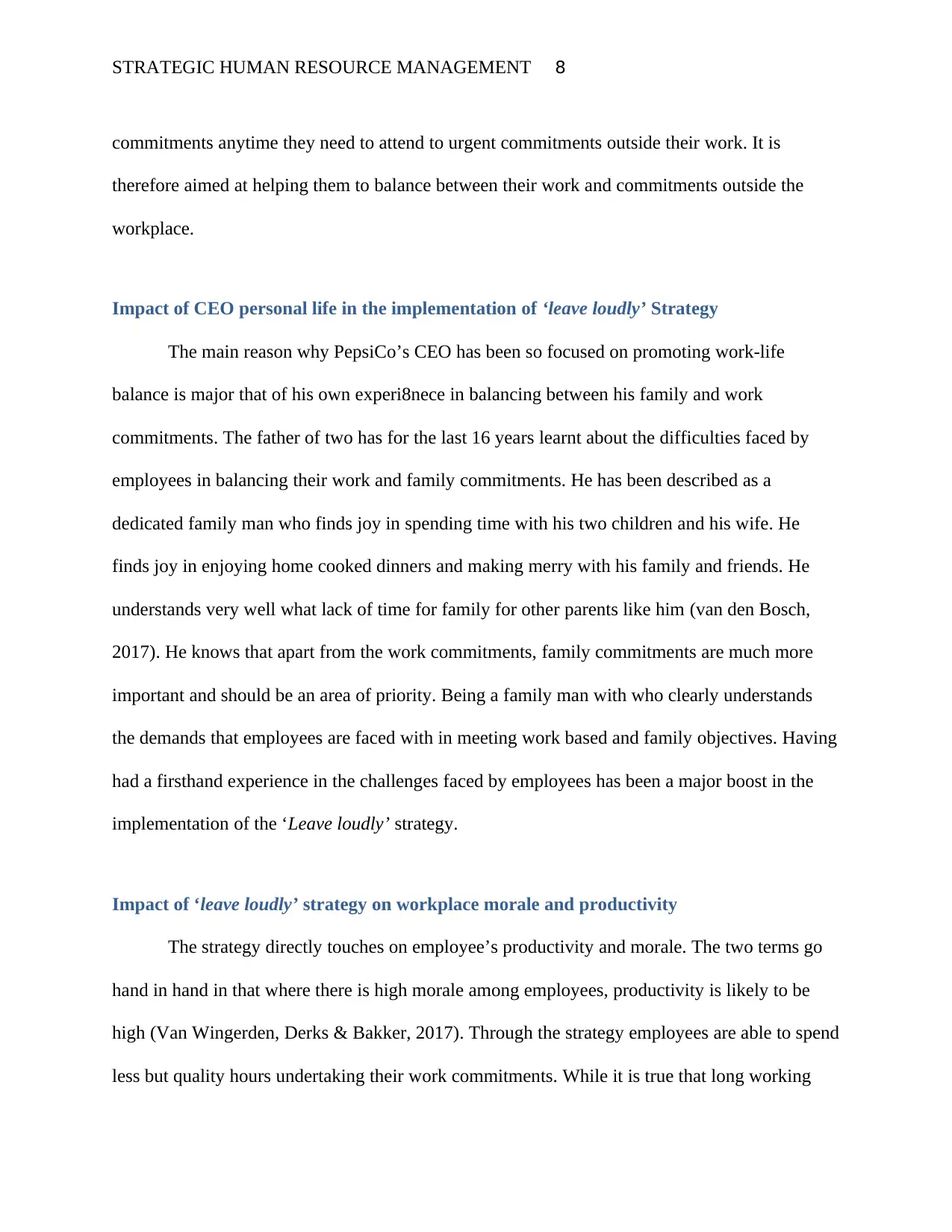
STRATEGIC HUMAN RESOURCE MANAGEMENT 8
commitments anytime they need to attend to urgent commitments outside their work. It is
therefore aimed at helping them to balance between their work and commitments outside the
workplace.
Impact of CEO personal life in the implementation of ‘leave loudly’ Strategy
The main reason why PepsiCo’s CEO has been so focused on promoting work-life
balance is major that of his own experi8nece in balancing between his family and work
commitments. The father of two has for the last 16 years learnt about the difficulties faced by
employees in balancing their work and family commitments. He has been described as a
dedicated family man who finds joy in spending time with his two children and his wife. He
finds joy in enjoying home cooked dinners and making merry with his family and friends. He
understands very well what lack of time for family for other parents like him (van den Bosch,
2017). He knows that apart from the work commitments, family commitments are much more
important and should be an area of priority. Being a family man with who clearly understands
the demands that employees are faced with in meeting work based and family objectives. Having
had a firsthand experience in the challenges faced by employees has been a major boost in the
implementation of the ‘Leave loudly’ strategy.
Impact of ‘leave loudly’ strategy on workplace morale and productivity
The strategy directly touches on employee’s productivity and morale. The two terms go
hand in hand in that where there is high morale among employees, productivity is likely to be
high (Van Wingerden, Derks & Bakker, 2017). Through the strategy employees are able to spend
less but quality hours undertaking their work commitments. While it is true that long working
commitments anytime they need to attend to urgent commitments outside their work. It is
therefore aimed at helping them to balance between their work and commitments outside the
workplace.
Impact of CEO personal life in the implementation of ‘leave loudly’ Strategy
The main reason why PepsiCo’s CEO has been so focused on promoting work-life
balance is major that of his own experi8nece in balancing between his family and work
commitments. The father of two has for the last 16 years learnt about the difficulties faced by
employees in balancing their work and family commitments. He has been described as a
dedicated family man who finds joy in spending time with his two children and his wife. He
finds joy in enjoying home cooked dinners and making merry with his family and friends. He
understands very well what lack of time for family for other parents like him (van den Bosch,
2017). He knows that apart from the work commitments, family commitments are much more
important and should be an area of priority. Being a family man with who clearly understands
the demands that employees are faced with in meeting work based and family objectives. Having
had a firsthand experience in the challenges faced by employees has been a major boost in the
implementation of the ‘Leave loudly’ strategy.
Impact of ‘leave loudly’ strategy on workplace morale and productivity
The strategy directly touches on employee’s productivity and morale. The two terms go
hand in hand in that where there is high morale among employees, productivity is likely to be
high (Van Wingerden, Derks & Bakker, 2017). Through the strategy employees are able to spend
less but quality hours undertaking their work commitments. While it is true that long working
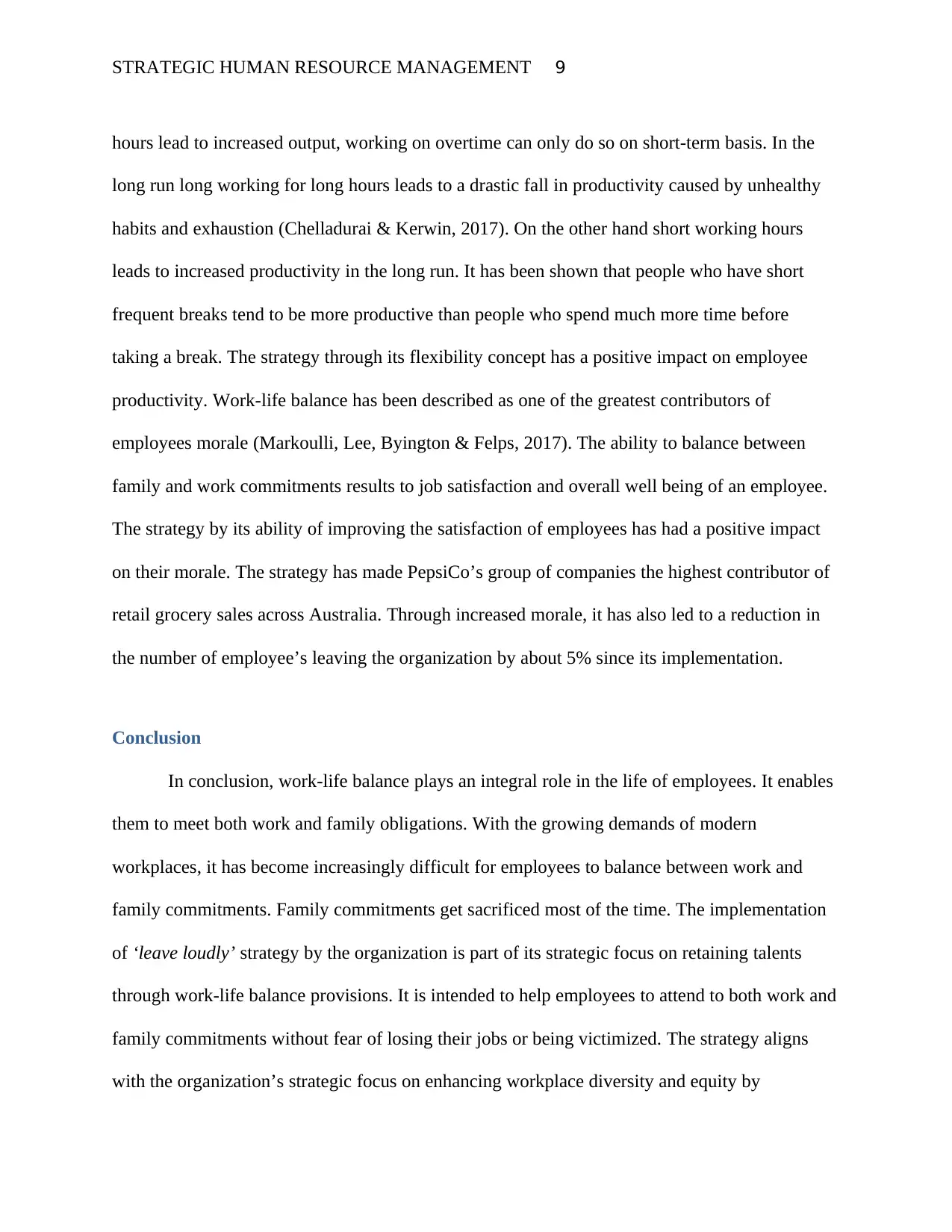
STRATEGIC HUMAN RESOURCE MANAGEMENT 9
hours lead to increased output, working on overtime can only do so on short-term basis. In the
long run long working for long hours leads to a drastic fall in productivity caused by unhealthy
habits and exhaustion (Chelladurai & Kerwin, 2017). On the other hand short working hours
leads to increased productivity in the long run. It has been shown that people who have short
frequent breaks tend to be more productive than people who spend much more time before
taking a break. The strategy through its flexibility concept has a positive impact on employee
productivity. Work-life balance has been described as one of the greatest contributors of
employees morale (Markoulli, Lee, Byington & Felps, 2017). The ability to balance between
family and work commitments results to job satisfaction and overall well being of an employee.
The strategy by its ability of improving the satisfaction of employees has had a positive impact
on their morale. The strategy has made PepsiCo’s group of companies the highest contributor of
retail grocery sales across Australia. Through increased morale, it has also led to a reduction in
the number of employee’s leaving the organization by about 5% since its implementation.
Conclusion
In conclusion, work-life balance plays an integral role in the life of employees. It enables
them to meet both work and family obligations. With the growing demands of modern
workplaces, it has become increasingly difficult for employees to balance between work and
family commitments. Family commitments get sacrificed most of the time. The implementation
of ‘leave loudly’ strategy by the organization is part of its strategic focus on retaining talents
through work-life balance provisions. It is intended to help employees to attend to both work and
family commitments without fear of losing their jobs or being victimized. The strategy aligns
with the organization’s strategic focus on enhancing workplace diversity and equity by
hours lead to increased output, working on overtime can only do so on short-term basis. In the
long run long working for long hours leads to a drastic fall in productivity caused by unhealthy
habits and exhaustion (Chelladurai & Kerwin, 2017). On the other hand short working hours
leads to increased productivity in the long run. It has been shown that people who have short
frequent breaks tend to be more productive than people who spend much more time before
taking a break. The strategy through its flexibility concept has a positive impact on employee
productivity. Work-life balance has been described as one of the greatest contributors of
employees morale (Markoulli, Lee, Byington & Felps, 2017). The ability to balance between
family and work commitments results to job satisfaction and overall well being of an employee.
The strategy by its ability of improving the satisfaction of employees has had a positive impact
on their morale. The strategy has made PepsiCo’s group of companies the highest contributor of
retail grocery sales across Australia. Through increased morale, it has also led to a reduction in
the number of employee’s leaving the organization by about 5% since its implementation.
Conclusion
In conclusion, work-life balance plays an integral role in the life of employees. It enables
them to meet both work and family obligations. With the growing demands of modern
workplaces, it has become increasingly difficult for employees to balance between work and
family commitments. Family commitments get sacrificed most of the time. The implementation
of ‘leave loudly’ strategy by the organization is part of its strategic focus on retaining talents
through work-life balance provisions. It is intended to help employees to attend to both work and
family commitments without fear of losing their jobs or being victimized. The strategy aligns
with the organization’s strategic focus on enhancing workplace diversity and equity by
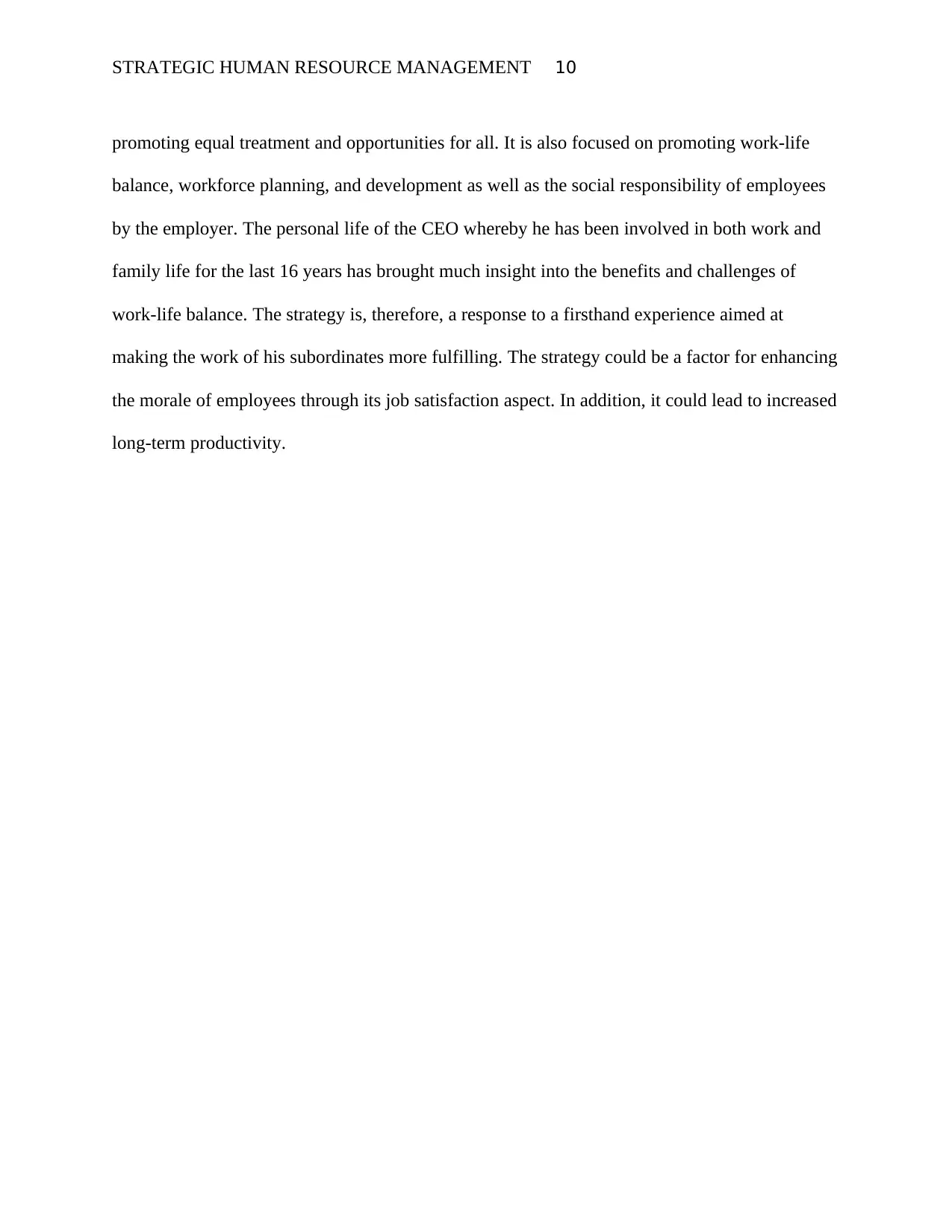
STRATEGIC HUMAN RESOURCE MANAGEMENT 10
promoting equal treatment and opportunities for all. It is also focused on promoting work-life
balance, workforce planning, and development as well as the social responsibility of employees
by the employer. The personal life of the CEO whereby he has been involved in both work and
family life for the last 16 years has brought much insight into the benefits and challenges of
work-life balance. The strategy is, therefore, a response to a firsthand experience aimed at
making the work of his subordinates more fulfilling. The strategy could be a factor for enhancing
the morale of employees through its job satisfaction aspect. In addition, it could lead to increased
long-term productivity.
promoting equal treatment and opportunities for all. It is also focused on promoting work-life
balance, workforce planning, and development as well as the social responsibility of employees
by the employer. The personal life of the CEO whereby he has been involved in both work and
family life for the last 16 years has brought much insight into the benefits and challenges of
work-life balance. The strategy is, therefore, a response to a firsthand experience aimed at
making the work of his subordinates more fulfilling. The strategy could be a factor for enhancing
the morale of employees through its job satisfaction aspect. In addition, it could lead to increased
long-term productivity.
Secure Best Marks with AI Grader
Need help grading? Try our AI Grader for instant feedback on your assignments.
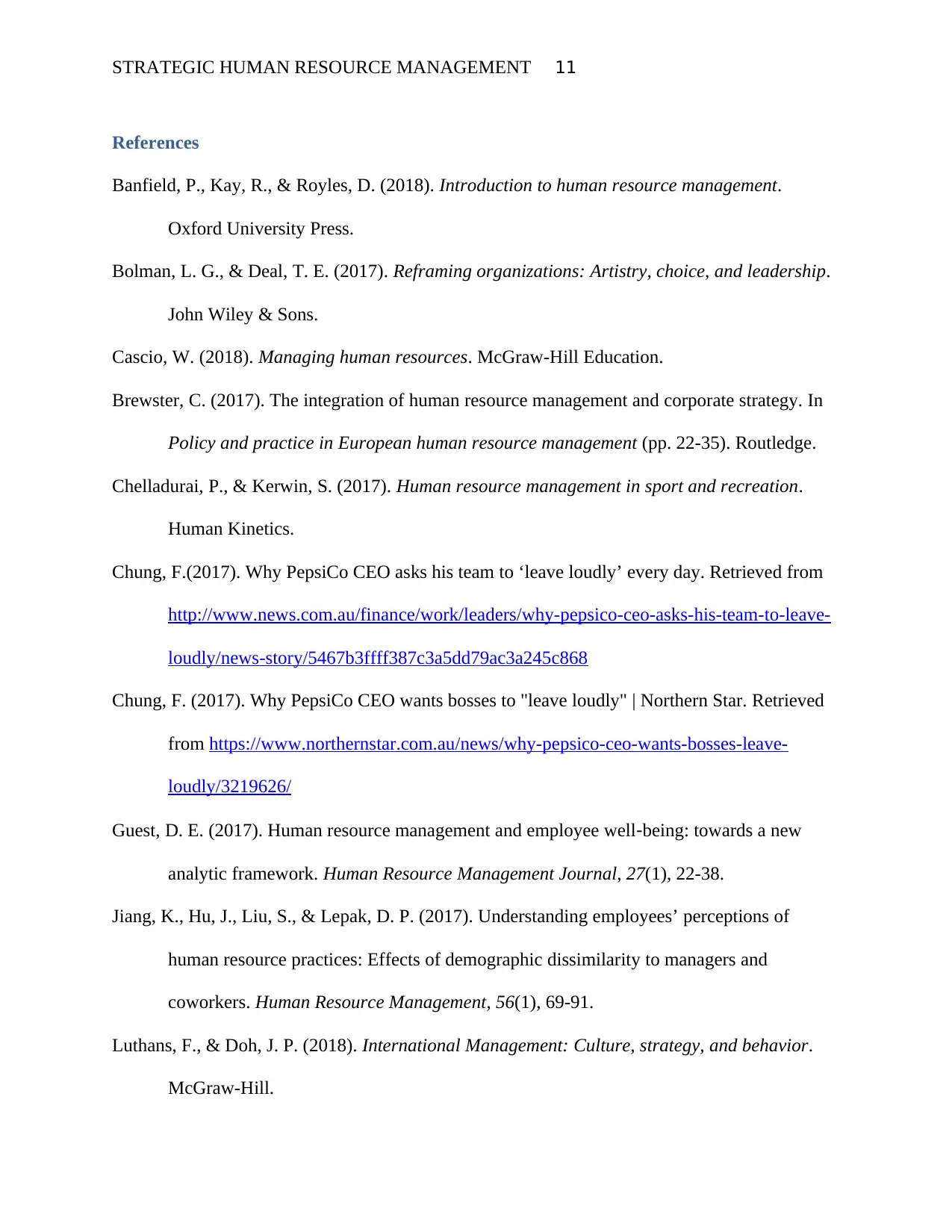
STRATEGIC HUMAN RESOURCE MANAGEMENT 11
References
Banfield, P., Kay, R., & Royles, D. (2018). Introduction to human resource management.
Oxford University Press.
Bolman, L. G., & Deal, T. E. (2017). Reframing organizations: Artistry, choice, and leadership.
John Wiley & Sons.
Cascio, W. (2018). Managing human resources. McGraw-Hill Education.
Brewster, C. (2017). The integration of human resource management and corporate strategy. In
Policy and practice in European human resource management (pp. 22-35). Routledge.
Chelladurai, P., & Kerwin, S. (2017). Human resource management in sport and recreation.
Human Kinetics.
Chung, F.(2017). Why PepsiCo CEO asks his team to ‘leave loudly’ every day. Retrieved from
http://www.news.com.au/finance/work/leaders/why-pepsico-ceo-asks-his-team-to-leave-
loudly/news-story/5467b3ffff387c3a5dd79ac3a245c868
Chung, F. (2017). Why PepsiCo CEO wants bosses to "leave loudly" | Northern Star. Retrieved
from https://www.northernstar.com.au/news/why-pepsico-ceo-wants-bosses-leave-
loudly/3219626/
Guest, D. E. (2017). Human resource management and employee well‐being: towards a new
analytic framework. Human Resource Management Journal, 27(1), 22-38.
Jiang, K., Hu, J., Liu, S., & Lepak, D. P. (2017). Understanding employees’ perceptions of
human resource practices: Effects of demographic dissimilarity to managers and
coworkers. Human Resource Management, 56(1), 69-91.
Luthans, F., & Doh, J. P. (2018). International Management: Culture, strategy, and behavior.
McGraw-Hill.
References
Banfield, P., Kay, R., & Royles, D. (2018). Introduction to human resource management.
Oxford University Press.
Bolman, L. G., & Deal, T. E. (2017). Reframing organizations: Artistry, choice, and leadership.
John Wiley & Sons.
Cascio, W. (2018). Managing human resources. McGraw-Hill Education.
Brewster, C. (2017). The integration of human resource management and corporate strategy. In
Policy and practice in European human resource management (pp. 22-35). Routledge.
Chelladurai, P., & Kerwin, S. (2017). Human resource management in sport and recreation.
Human Kinetics.
Chung, F.(2017). Why PepsiCo CEO asks his team to ‘leave loudly’ every day. Retrieved from
http://www.news.com.au/finance/work/leaders/why-pepsico-ceo-asks-his-team-to-leave-
loudly/news-story/5467b3ffff387c3a5dd79ac3a245c868
Chung, F. (2017). Why PepsiCo CEO wants bosses to "leave loudly" | Northern Star. Retrieved
from https://www.northernstar.com.au/news/why-pepsico-ceo-wants-bosses-leave-
loudly/3219626/
Guest, D. E. (2017). Human resource management and employee well‐being: towards a new
analytic framework. Human Resource Management Journal, 27(1), 22-38.
Jiang, K., Hu, J., Liu, S., & Lepak, D. P. (2017). Understanding employees’ perceptions of
human resource practices: Effects of demographic dissimilarity to managers and
coworkers. Human Resource Management, 56(1), 69-91.
Luthans, F., & Doh, J. P. (2018). International Management: Culture, strategy, and behavior.
McGraw-Hill.
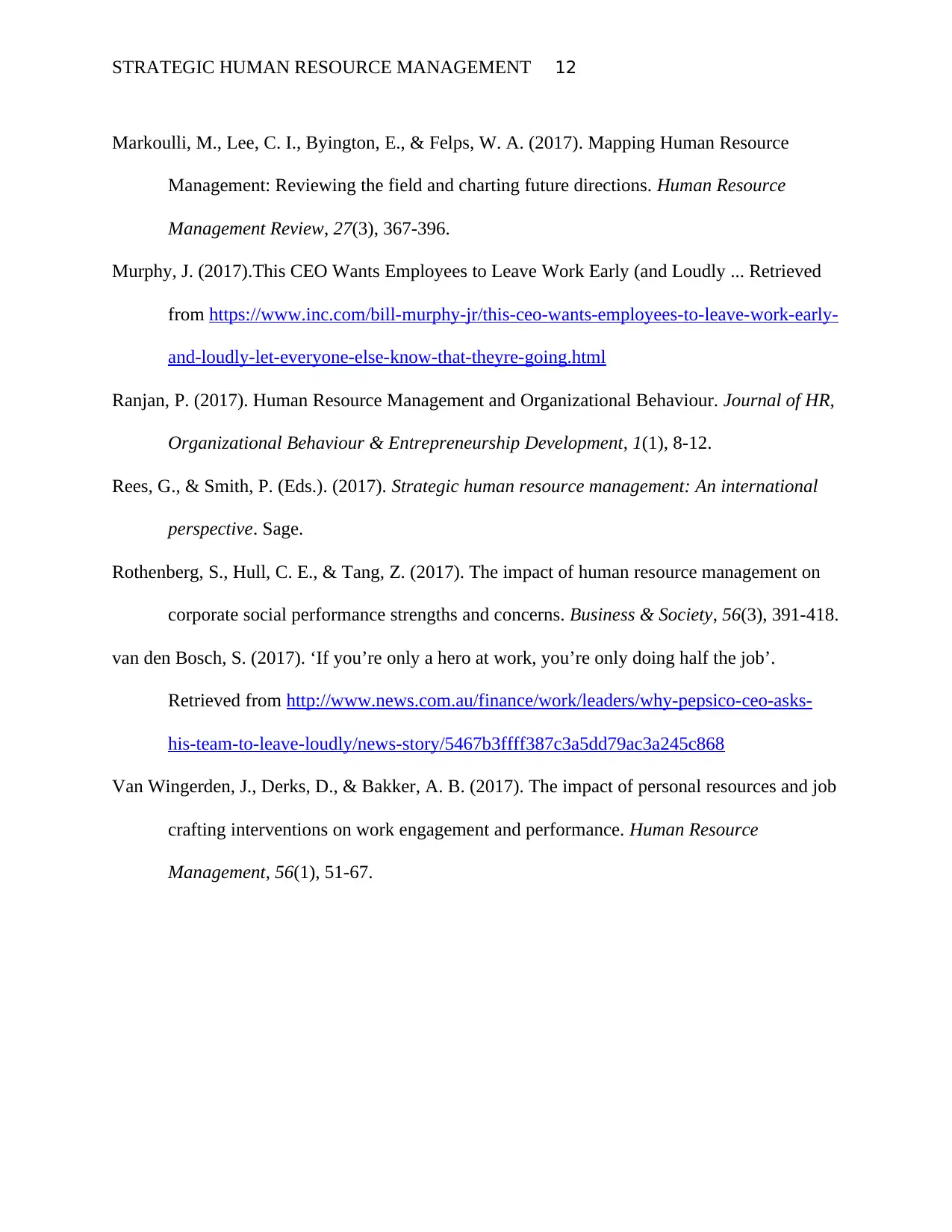
STRATEGIC HUMAN RESOURCE MANAGEMENT 12
Markoulli, M., Lee, C. I., Byington, E., & Felps, W. A. (2017). Mapping Human Resource
Management: Reviewing the field and charting future directions. Human Resource
Management Review, 27(3), 367-396.
Murphy, J. (2017).This CEO Wants Employees to Leave Work Early (and Loudly ... Retrieved
from https://www.inc.com/bill-murphy-jr/this-ceo-wants-employees-to-leave-work-early-
and-loudly-let-everyone-else-know-that-theyre-going.html
Ranjan, P. (2017). Human Resource Management and Organizational Behaviour. Journal of HR,
Organizational Behaviour & Entrepreneurship Development, 1(1), 8-12.
Rees, G., & Smith, P. (Eds.). (2017). Strategic human resource management: An international
perspective. Sage.
Rothenberg, S., Hull, C. E., & Tang, Z. (2017). The impact of human resource management on
corporate social performance strengths and concerns. Business & Society, 56(3), 391-418.
van den Bosch, S. (2017). ‘If you’re only a hero at work, you’re only doing half the job’.
Retrieved from http://www.news.com.au/finance/work/leaders/why-pepsico-ceo-asks-
his-team-to-leave-loudly/news-story/5467b3ffff387c3a5dd79ac3a245c868
Van Wingerden, J., Derks, D., & Bakker, A. B. (2017). The impact of personal resources and job
crafting interventions on work engagement and performance. Human Resource
Management, 56(1), 51-67.
Markoulli, M., Lee, C. I., Byington, E., & Felps, W. A. (2017). Mapping Human Resource
Management: Reviewing the field and charting future directions. Human Resource
Management Review, 27(3), 367-396.
Murphy, J. (2017).This CEO Wants Employees to Leave Work Early (and Loudly ... Retrieved
from https://www.inc.com/bill-murphy-jr/this-ceo-wants-employees-to-leave-work-early-
and-loudly-let-everyone-else-know-that-theyre-going.html
Ranjan, P. (2017). Human Resource Management and Organizational Behaviour. Journal of HR,
Organizational Behaviour & Entrepreneurship Development, 1(1), 8-12.
Rees, G., & Smith, P. (Eds.). (2017). Strategic human resource management: An international
perspective. Sage.
Rothenberg, S., Hull, C. E., & Tang, Z. (2017). The impact of human resource management on
corporate social performance strengths and concerns. Business & Society, 56(3), 391-418.
van den Bosch, S. (2017). ‘If you’re only a hero at work, you’re only doing half the job’.
Retrieved from http://www.news.com.au/finance/work/leaders/why-pepsico-ceo-asks-
his-team-to-leave-loudly/news-story/5467b3ffff387c3a5dd79ac3a245c868
Van Wingerden, J., Derks, D., & Bakker, A. B. (2017). The impact of personal resources and job
crafting interventions on work engagement and performance. Human Resource
Management, 56(1), 51-67.
1 out of 12
Related Documents
Your All-in-One AI-Powered Toolkit for Academic Success.
+13062052269
info@desklib.com
Available 24*7 on WhatsApp / Email
![[object Object]](/_next/static/media/star-bottom.7253800d.svg)
Unlock your academic potential
© 2024 | Zucol Services PVT LTD | All rights reserved.




